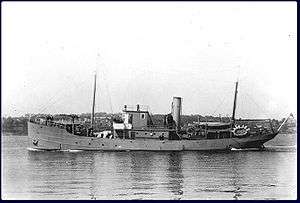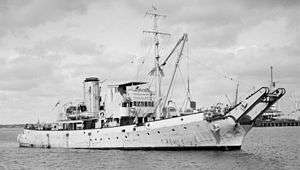Net laying ship
A net laying ship, also known as a net layer, net tender, gate ship or boom defence vessel was a type of small auxiliary ship.
A net layer's primary function was to lay and maintain steel anti-torpedo or anti-submarine nets. Nets could be laid around an individual ship at anchor, or around harbors or other anchorages. Net laying was potentially dangerous work, and net laying seamen were experts at dealing with blocks, tackles, knots and splicing. As World War II progressed, net layers were pressed into a variety of additional roles including salvage, troop and cargo transport, buoy maintenance, and service as tugboats.
US Navy
| General characteristics (US Navy netlayers) | |
| Displacement: | 560 tons, 700 tons laden |
| Length: | 151 ft. 8 in. |
| Beam: | 30 ft. 6 in. |
| Draft: | 10 ft. 6 in. |
| Speed: | 14 knots |
| Propulsion: | Diesel, single screw |
| Complement: | 40 |
| Armament: | 1 x 3"/50 caliber dual purpose gun, 3 x 20mm mounts |
Net layers initially received the hull classification symbol YN (for "Yard Net Tender") but were later reclassified AN (for "Auxiliary Net Layer"). The British Admiralty knew such ships as a “boom defence vessel".
The first 32, all launched in 1940 (before the attack on Pearl Harbor), were built of steel. Due to the chronic shortage of steel during the war, the next 30 were built of wood. The last 15, laid down in 1944 and 1945, were again constructed of steel.
A total of 77 net layers of all classes served with the US Navy during the war. The vessels served in all theatres of war but particularly in the Pacific. Many of the ships were decommissioned after the war, but some continued in service for several more decades. Net layers were eventually made redundant by advances in underwater detection technology.
United States Navy net layers had two prominent steel "horns" on the bow, used in laying nets. British boom defence vessels notably lacked these.
Gallery
 The boom defence net at Scapa Flow being towed into position by two Royal Navy boom defence vessels in 1943.
The boom defence net at Scapa Flow being towed into position by two Royal Navy boom defence vessels in 1943. At Scapa Flow, a Royal Navy net laying vessel prepares to lay an anti-submarine net, which is 900 feet (275 metres) long, weighs over 40 Imperial tons (41 tonnes) and could be laid in 4 minutes.
At Scapa Flow, a Royal Navy net laying vessel prepares to lay an anti-submarine net, which is 900 feet (275 metres) long, weighs over 40 Imperial tons (41 tonnes) and could be laid in 4 minutes. HMS Rogate, a Royal Navy "gate vessel" designed to open and close the boom and nets at Portsmouth Harbour during World War II.
HMS Rogate, a Royal Navy "gate vessel" designed to open and close the boom and nets at Portsmouth Harbour during World War II. HMCS Ypres was a Battle class trawler used by the Royal Canadian Navy as a gate vessel. She was sunk in a collision with a battleship in May 1940.
HMCS Ypres was a Battle class trawler used by the Royal Canadian Navy as a gate vessel. She was sunk in a collision with a battleship in May 1940..jpg) The US Navy wooden Net Tender, USS Terebinth (AN-59) in wartime camouflage.
The US Navy wooden Net Tender, USS Terebinth (AN-59) in wartime camouflage. HMAS Kangaroo, a Bar class boom defence vessel of the Royal Australian Navy in 1947.
HMAS Kangaroo, a Bar class boom defence vessel of the Royal Australian Navy in 1947.
References
- Jurens, W. (2016). "Life in the Slow Lane: Some Thoughts on Minelayer and Netlayer Evolution". Warship International. LIII (1): 59–68. ISSN 0043-0374.